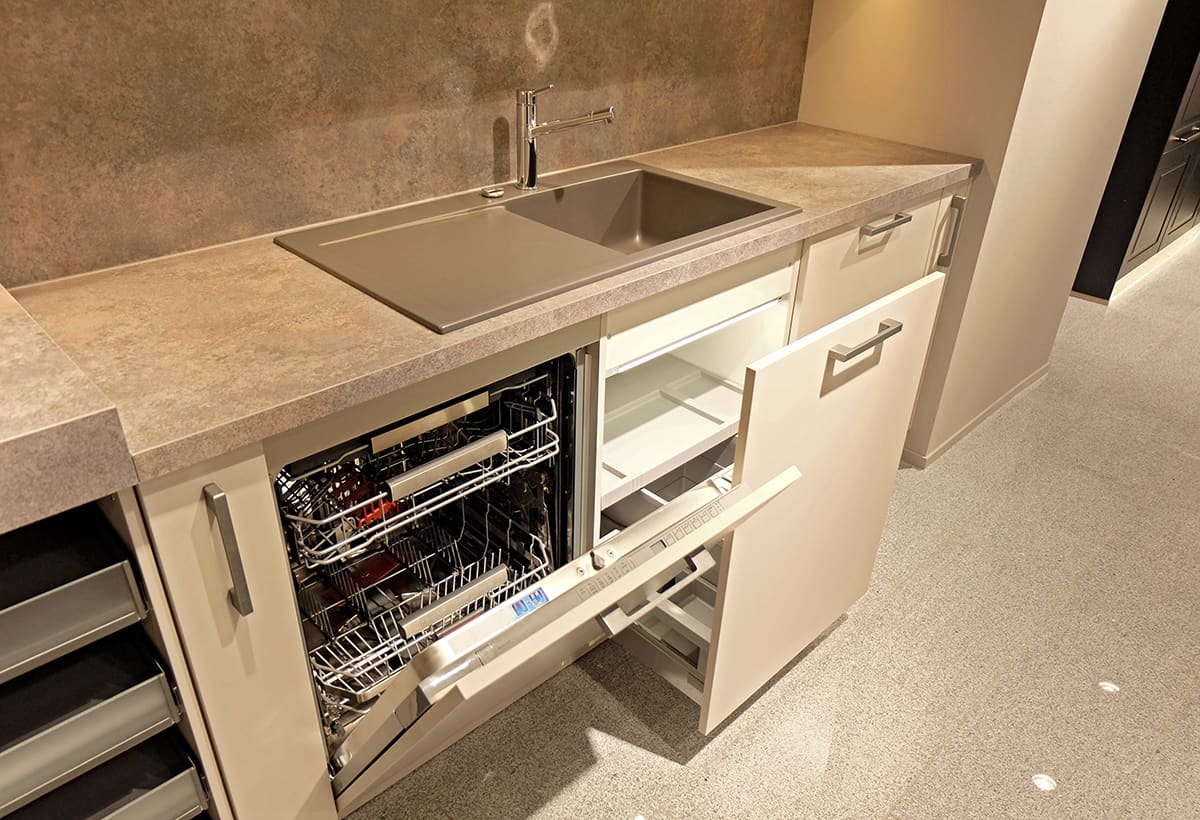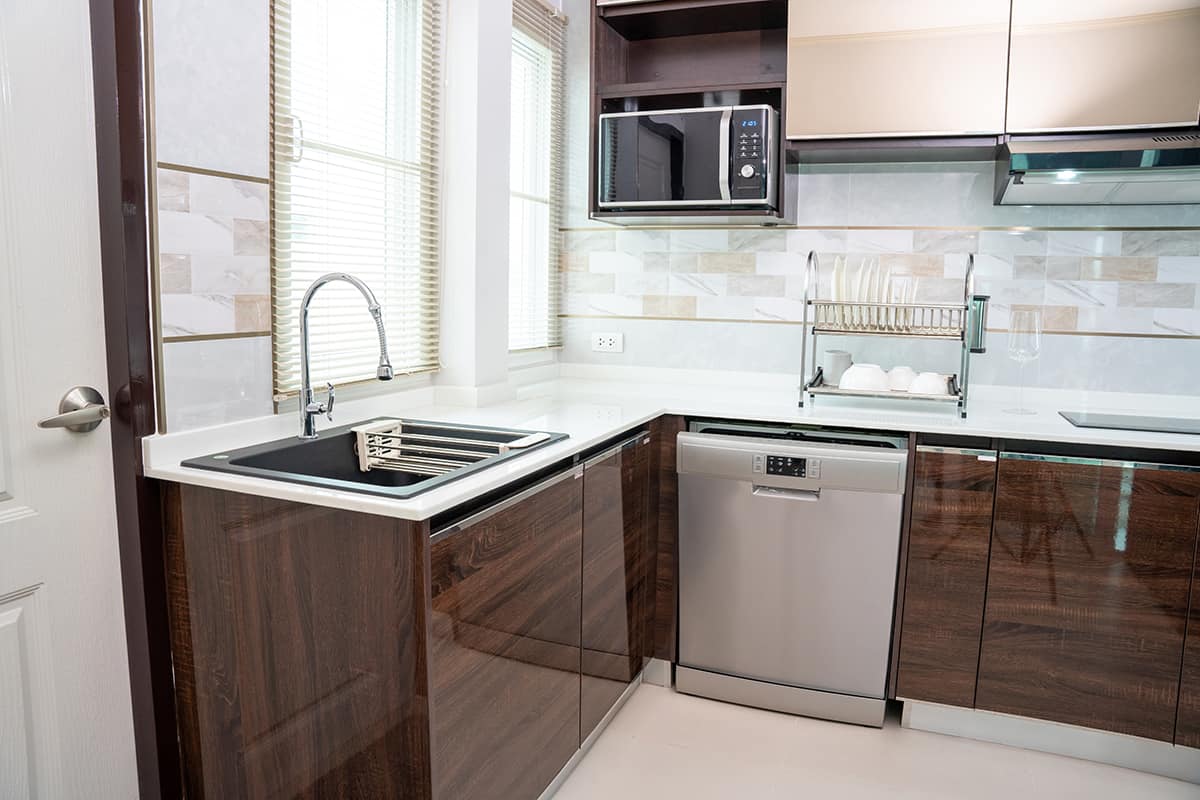When it comes to kitchen appliances, you should measure them twice and purchase them once. The problem is, even after careful measuring, there’s still a risk of your dishwasher being too tall to fit in your cabinets. So, what are your options when you experience dishwasher height problems like this?
You have several options for adjusting the height of your dishwasher:
- Adjust the legs
- Replace the adjustable legs
- Use slabs to prop up the dishwasher
- Remove some material from the underside of your countertop
- Move the dishwasher to another spot
- Replace the countertop or cabinets
- Purchase a new dishwasher
In this guide, I’ll explain these alternatives in more detail, as well as the proper way to fit a dishwasher inside a cabinet.
Dishwasher Height Problems
The average size of a dishwasher varies from brand to brand. The industry average is roughly 24 inches wide, 24 inches deep, and 35 inches tall, which is compact enough to fit in a hatchback. If you were to look at a specific brand, such as Bosch, you’d find dishwashers that stand about 34 inches tall across the board.
But the biggest problem regarding dishwasher heights isn’t whether or not they’ll fit in your car but rather, will they fit in your cabinet?
How to Size an Under-the-Cabinet Dishwasher

There are several reasons why you should consider installing a dishwasher underneath your countertop. For instance, it will keep noise levels down, and it can even increase the value of your home! But before you think about designing the kitchen of your dreams, you first need to make sure your dishwasher will fit under your countertop and between 2 adjacent cabinets.
Follow this 3-step guide to figure out how to properly size your kitchen for an integrated dishwasher.
1. Measure the distance between the cabinets
Using a tape measure, record the empty space between the 2 cabinets where you wish to install your dishwasher. Ideally, your dishwasher will be about 1 inch narrower than this distance, giving ½ of an inch of clearance on each side.
For instance, if the average dishwasher is 24 inches wide, there should be at least 25 inches of space between the cabinets. If you’re opting for a wider dishwasher, adjust your calculations accordingly.
2. Measure the distance between the front and back of the cabinet
Now, measure the distance between the back wall of the cabinets and the front of the open space for your dishwasher. Ideally, the depth will be exactly as depth as your dishwasher. For the average dishwasher, that’s 24 inches.
If your cabinets are deeper than 24 inches, you can position your dishwasher so that it’s more toward the opening than it is flush in the back. That way, you won’t have to reach your arm into the open space to grab the dishwasher door handle.
In addition, you should also consider how much empty space there is in front of the dishwasher since the dishwasher door swings outward. In most cases, the door will take up 27 inches of space in front of the dishwasher.
3. Measure the distance between the floor and the underside of your countertop
The last and most crucial thing you need to measure is the height of the cabinet space. Take your tape measure and carefully record the distance between the bottom of the cabinet (i.e., the floor) and the bottom of your countertop.
Most dishwashers stand 34 inches tall, but you should leave around a 2-inch gap between the top of the dishwasher and the underside of your countertop to allow steam to vent. For example, if the height between the floor and countertop is 37 inches tall, you need a dishwasher that’s 35 inches tall.
You can also push it to 36 inches, but you also need to consider what a smaller steam vent can do to the adjacent cabinets.
Dishwasher Height Problems
Most forward-thinking home designers will already take the 24 × 24-inch footprint of a dishwasher into account. The only real problem is figuring out how high to leave the dishwasher cabinet since the height of a dishwasher can vary pretty significantly.
For example, what should you do if you have an existing dishwasher that’s 3 inches shorter than the cabinet opening or—worse—if it’s taller?
The good news is that you don’t need to begin demolishing your kitchen to adjust your cabinet for your dishwasher. However, in extreme situations, this may be your only option short of purchasing a brand-new dishwasher.
Below, I’ll offer a few alternatives for what you can do to adjust your dishwasher’s height.
Dishwasher too short
Let’s start with the easier height problem—if your dishwasher is too short for the cabinet opening.
1. Adjust the legs
Dishwasher manufacturers usually take into account the varying heights of cabinet openings. That’s why you’ll find adjustable legs underneath brand-new dishwashers. You can adjust the height of your dishwasher by rotating the legs until the top of the dishwasher is as high as you want it.
2. Replace the adjustable legs
But what if the cabinet space for your dishwasher is abnormally tall (38 inches or so)? You can reach out to the manufacturer and inquire about replacement adjustable legs that are taller than the stock options.
The downside of this alternative is that you’ll see more of the metal rod keeping the dishwasher up and off the ground. The good news is that lifting your dishwasher higher than normal will allow more steam and moisture to escape the dishwasher, possibly reducing moisture-related damage to the adjacent cabinets.
3. Use slabs to prop up the dishwasher
This might seem like a ghetto solution, but it’s incredibly effective. If your dishwasher is too short for the cabinet space, cut a few spare blocks of wood to size, and use them to prop up the dishwasher. Ideally, the makeshift legs will be made of waterproof material or coated in a waterproof sealant to prevent moisture damage from steam and water droplets.
Again, people in your kitchen will get a view of your DIY solution in action, which might not look so great.
Dishwasher too High
With that out of the way, we can focus on the more problematic height issue, which is when your dishwasher is too tall for the cabinet opening.
1. Remove some material from the underside of your countertop
Take a look at the underside of your cabinet and try to figure out whether it’s possible to shave some of it off. Yes, this sounds extreme, but the alternative is to replace the countertop entirely with a more fitting version.
The good news is that you can even shave the underside of a granite countertop, though it’ll be painstakingly long to do so. After measuring how much you need to remove, carefully file down the bottom of the countertop until there’s enough room to fit your dishwasher.
2. Move the dishwasher to another spot
This is the more realistic alternative, though it’s not always available for every household. If you can move the dishwasher to another open cabinet space in your kitchen, or if there’s another room in your home where you don’t mind installing your dishwasher, you should consider doing so.
3. Replace the countertop or cabinets
This is one of the costlier alternatives for solving your dishwasher height conundrum, but it’s worth doing if you’re already in the middle of renovating your kitchen. Make sure you know the dimensions of your dishwasher (follow the guide above) before settling on where you create the space for the appliance.
4. Purchase a new dishwasher
Spending another $400 to $2,000 on a brand-new dishwasher of the correct size might seem a bit out there, but it’s a lot more cost-effective than the previous alternative.
After measuring the cabinet space for your dishwasher, ask a sales rep to find the perfect dishwasher fit. Remember that it’s safer to go a bit smaller than it is to go even a fraction of an inch too big.
Are Countertop Dishwashers Worth It?

Yes, they are, especially if you don’t need to wash more than 5 or 6 place settings at once.
Countertop dishwashers, also known as portable dishwashers, are dishwashers that fit right on top of your counter or any flat surface. They take up much less square footage than their full-sized counterparts, and they’re quick and easy to supply with water.
This type of dishwasher is usually reserved for RVs or apartments—basically, any place that doesn’t have enough space for a full-sized unit. Generally speaking, countertop dishwashers use less water and detergent, making them incredibly cost-efficient if you live in a household with fewer than 4 members.
With all that said, there are a few cons worth mentioning. The first is that countertop dishwashers are not nearly as good-looking as integrated dishwashers. Luckily, you can store it out of view whenever you’re not using it.
Secondly, they’re incredibly small. It would take multiple wash cycles to clean the same number of dishes as a full-sized can in a single cycle.
Finally, there aren’t as many wash options in countertop dishwashers. So, if you want to sanitize your dishes, you’ll have to do so manually.






